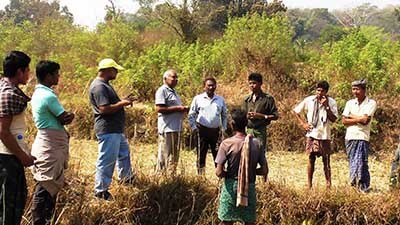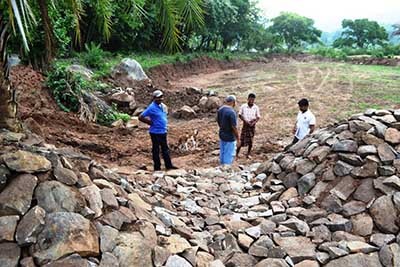RAIN WATER MANAGEMENT
RAIN WATER MANAGEMENT
BACKGROUND
Ultimate source of all water is rain and it falls equally and indiscriminately everywhere. Odisha receives an annual rain-fall of 1500mm, which is substantially high in comparison to other Indian states. But in the onset of summer season every year, one does not miss reports of water crisis/conflicts/disputes almost every day. On the other hand monsoon brings in devastative floods leaving standing crops inundated for days together, spoiling crops, farmers’ labour and their investments. Therefore the inhabitants suffer both from the excess of water to scarcity of it, at various periods and different geographies with different magnitudes. Further, as 80% of the State’s croplands are dependent on monsoon rain and crop failures due to erratic rainfall patterns are reported almost every year. Because whatever rain the state receives, about 40% of it is lost through surface runoff, 37% of it through unproductive evaporation. Only 10% of the entire rainwater could be retained through manmade storage structures and 13% through natural retention.


RAIN WATER MANAGEMENT
WHAT SHOULD BE OUR PRIORITIES?
It is well understood by now that poor management of rainwater is the major reason. Therefore, improving dependability of whatever water we get to secure water for all purposes appear to be our first priority. Further, in the context of providing year round livelihood activity to the majority of households, who depend upon agriculture, an increased cropping intensity substantially becomes highly relevant as the second priority. Both the priorities demand storage of adequate quantity of water out of the annual precipitation. The third priority is to improve the field condition of the small and marginal farmers, who constitute 83% of State’s farming population.

RAIN WATER MANAGEMENT
SOLUTION TO THE PROBLEM
Rain water management, based on the principle of mass land development, is the most effective system to establish water security. The system involves all the landmass coming under the geographical limit of a village and thus involves all the farmers and landholders in a village. The system is based on the principle of increasing the duration of surface runoff to increase water percolation into the ground and thus increasing the groundwater level of a particular region.
The soil mass, which happens to be a porous media, given adequate time, can absorb the entire precipitation. The aggregate volume of porosity is 2-3 times the volume of precipitation received in a village. Thus nature has created enough storage space but human intervention has manipulated the natural system adversely. In the past, the intense forest cover used to store water and release it slowly. With the depletion of forest cover, rainwater barely stays 30 minutes over the ground while the infiltration duration is 75mm per hour. Thus majority of the rainwater is wasted as surface runoff. If we want 750mm water, which is the volumetric water requirement of a 200% intensive cropping (50%) of Odisha’s average rainfall, the quantity of runoff desired to be infiltrated must stay within the village for at least 10 hours. The current practice is to construct surface reservoirs, which have not been anywhere near achieving the objective. The highest ever cropping intensity in the most flourishing irrigation project is hardly 150%. But this method of Rain Water Management will utilise the precipitation not only for cropping, but also for drinking, washing and bathing, cattle growing, flood control and creating an off-season flow in the local streams and rivers.


RAIN WATER MANAGEMENT
WHY RAIN WATER MANAGEMENT?
- The system does not disturb the village topography, thus eliminates the problem of land acquisition / rehabilitation.
- The first beneficiary is the poorest of the farmer whose land is normally located in the highlands.
- The whole village becomes drought free and the water table raises to such an extent that even Rabi crop becomes possible by lifting water from shallow wells. Low lands become fit for summer paddy. Thus enhanced livelihood security can be established.
- The system ensures high water level in wells, tube wells, ponds, tanks, rivers and rivulets even during peak summer seasons and thus establishes water security for all types of life forms and livelihoods.
- The entire aquifer below the village becomes saturated thus diluting the ground contamination (bacteria, fluoride etc) to such an extent that it becomes fit for drinking.
- Outflow from the village becomes half during rains thus reducing storm surge in lower areas. vii. After the rain stops, the stored water is released slowly to the drains as off season flow thus making available water to villages in lower reaches.
- This creates enough employment inside the village thus reducing the menace of seasonal migration.
- This system will have to be participatory as it involves each and every family in a village.
- This the most cost effective approach to establish water security with least operation and maintenance related issues.
RAIN WATER MANAGEMENT
OUR PREVIOUS EXPERIENCE
SACAL, a grassroots NGO working in Gajapati and Ganjam districts of the State mostly works on (i) water, sanitation and community health, (ii) strengthening community based organisations, (iii) agriculture and sustainable livelihoods and (iv) natural resource management. SACAL experimented with rain water management system with considerable high results in Padmapur village under Malaspadar Gram Panchayat in Mohana block. The project completed phasewise in two years 2009-2010 and the impacts can be measured from the following:
RAIN WATER MANAGEMENT
ECONOMIC AND ENVIRONMENTAL ADVANTAGES
- The cost of the project is one hundredth of a normal irrigation project that would have provided similar benefits
- The environmental cost of such programme is invaluable as it does not disturb the land layout, forest cover and the physical structure. Rather the increased moisture content in the soil ensures enhanced biomass and land fertility.
- The increased water table in the village provides water for all domestic as well as irrigation purposes.
- Given the hilly and sloppy geographic feature of the region normally rain spells are followed by flash floods leading to soil erosion, land degradation and gully creation. All of the above problems are addressed through catchment area treatment.
- Farmers who used be sceptical about crop production in each kharrif are now going for double crops and per acre yield has increased from 6/8 quintals to 12/15 quintals of paddy in khariff and ravi seasons. Apart from this, summer vegetables are grown on a massive scale
- As major portion of the rainfall is retained in the village, the flood discharge is reduced to safe level.
- The initiative benefited all the farmers – small, marginal and big. In fact the small and marginal holders who normally acquire the medium and highlands in a village could secure their croplands from land degradation and water scarcity. The medium lands found to be fit for vegetable cultivation by Rabi season.
- Small water bodies, streams and rivulets those used to go dry by January end are being found perennial water sources.

